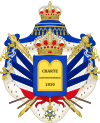- List of French monarchs
-
Monarchy of France Former Monarchy 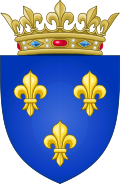
Coat of arms of France First monarch Clovis I
(as King of the Franks)Last monarch Napoleon III
(as Emperor)Style see Style of the French sovereign Appointer Hereditary Monarchy started 428 Monarchy ended 24 February 1848
(Royal Monarchy)
4 September 1870
(Imperial Monarchy)Current pretender Disputed
Louis of Bourbon
(House of Bourbon)
Henri of Orléans
(House of Orléans)
Jean Christophe Napoléon
(House of Bonaparte)The Monarchs of France ruled from the establishment of the Frankish Kingdom in 486 to 1870. During most of its history, France was ruled by kings. However, four Carolingian monarchs were also Holy Roman Emperors and the Bonapartes were Emperors of the French.
This article lists all rulers to have held the title "King of Franks", "King of France", "King of the French" or "Emperor of the French". For other Frankish monarchs, see List of Frankish Kings.
In addition to the monarchs listed below, the Kings of England and Great Britain from 1340–1360 and 1369–1801 also claimed the title of King of France. For a short time, this had some basis in fact — under the terms of the 1420 Treaty of Troyes, Charles VI had recognized his son-in-law Henry V of England as regent and heir. Henry V predeceased Charles VI and so Henry V's son, Henry VI, succeeded his grandfather Charles VI as King of France. Most of Northern France was under English control until 1435, but by 1453, the English had been expelled from all of France save Calais (and the Channel Islands), and Calais itself fell in 1558. Nevertheless, English and then British monarchs continued to claim the title for themselves until the creation of the United Kingdom in 1801. Various English kings between 1337 and 1422 had also claimed the title of King of France, but only intermittently.
The title "King of the Franks" (Latin: Rex Francorum) remained in use until the reign of Philip II. During the brief period when the French Constitution of 1791 was in effect (1791–1792) and after the July Revolution in 1830, the style "King of the French" was used instead of "King of France (and Navarre)". It was a constitutional innovation known as popular monarchy which linked the monarch's title to the will of the French people rather than to the possession of the territory of France.
Merovingian Dynasty (428–737)
The name of France comes from the Germanic tribe known as the Franks. The Merovingian kings began as mere chieftains, the oldest known being Chlodio. Clovis I was the first of these to rise to true kingship. After his death, his kingdom was split between his sons into Soissons (Neustria), Paris, Orléans (Burgundy), and Metz (Austrasia). Several Merovingian monarchs reunited the Frankish kingdoms and assumed the title of "King of the Franks". But upon their deaths, according to Frankish custom, the kingdom would often be split once again between their sons.
Portrait Name King From King Until Relationship with Predecessor(s) Title 
Chlodio the Longhair
(Clodion le Chevelu)428 448 • Son of Theudemeres King of the Salian Franks
(Roi des Francs saliens)
Merovech
(Mérovée)448 457 • Son of Chlodio King of the Salian Franks
(Roi des Francs saliens)
Childeric I
(Childéric Ier)457 481 • Son of Merovech King of the Salian Franks
(Roi des Francs saliens)
Clovis I
(Clovis Ier)481 511 • Son of Childeric I King of the Franks
(Roi des Francs)
Childebert I
(Childebert Ier)511 23 December 558 • Son of Clovis I King of Paris
(Roi de Paris)
Chlothar I the Old
(Clotaire Ier le Vieux)23 December 558 29 November 561 • Son of Clovis I
• Younger brother of Childebert IKing of the Franks
(Roi des Francs)
Charibert I
(Caribert Ier)29 November 561 567 • Son of Chlothar I King of Paris
(Roi de Paris)
Chilperic I
(Chilpéric Ier)567 584 • Son of Chlothar I
• Younger brother of Charibert IKing of Paris
(Roi de Paris)
King of Neustria
(Roi de Neustrie)
Chlothar II the Great, the Young
(Clotaire II le Grand, le Jeune)584 18 October 629 • Son of Chilperic I King of Neustria
(Roi de Neustrie)
King of Paris
(Roi de Paris)
(595–629)
King of the Franks
(Roi des Francs)
(613–629)
Dagobert I
(Dagobert Ier)18 October 629 19 January 639 • Son of Chlothar II King of the Franks
(Roi des Francs)
Clovis II the Lazy
(Clovis II le Fainéant)19 January 639 31 October 657 • Son of Dagobert I King of Neustria and Burgundy
(Roi de Neustrie et de Bourgogne)
Chlothar III
(Clotaire III)31 October 657 673 • Son of Clovis II King of Neustria and Burgundy
(Roi de Neustrie et de Bourgogne)
King of the Franks
(Roi des Francs)
(657–663)
Childeric II
(Childéric II)673 675 • Son of Clovis II
• Younger brother of Chlothar IIIKing of the Franks
(Roi des Francs)
Theuderic III
(Thierry III)675 691 • Son of Clovis II
• Younger brother of Childeric IIKing of Neustria
(Roi de Neustrie)
King of the Franks
(Roi des Francs)
(687–691)
Clovis IV
(Clovis IV)691 695 • Son of Theuderic III King of the Franks
(Roi des Francs)
Childebert III the Just
(Childebert III le Juste)695 23 April 711 • Son of Theuderic III
• Younger brother of Clovis IVKing of the Franks
(Roi des Francs)
Dagobert III 23 April 711 715 • Son of Childebert III King of the Franks
(Roi des Francs)
Chilperic II
(Chilpéric II)715 13 February 721 • Probably son of Childeric II King of Neustria and Burgundy
(Roi de Neustrie et de Bourgogne)
King of the Franks
(Roi des Francs)
(719–721)
Theuderic IV
(Thierry IV)13 February 721 737 • Son of Dagobert III King of the Franks
(Roi des Francs)Carolingian Interregnum (737–743)
The last Merovingian kings, known as the lazy kings (rois fainéants), did not hold any real political power, while the Mayor of the Palace governed instead. When Theuderic IV died in 737, Mayor of the Palace Charles Martel left the throne vacant and continued to rule until his own death in 741. His son Pepin the Short briefly restored the Merovingian dynasty by raising Childeric III to the throne in 743, only to depose him in 751.
Merovingian Dynasty, Restored (743–752)
Portrait Name King From King Until Relationship with Predecessor(s) Title 
Childeric III
(Childéric III)743 November 751 • Son of Chilperic II or of Theuderic IV King of the Franks
(Roi des Francs)Carolingian Dynasty (752–987)
Three of the twelve kings during the 147-year Carolingian Dynasty – Odo, his brother Robert I and Robert's son in law Raoul/Rudolph – were not from the Carolingian Dynasty but from the rival Robertian Dynasty, named for Robert the Strong (father of Odo and Robert I). The Robertian Dynasty became the Capetian Dynasty with the ascent to the throne of Hugh Capet (son of Hugh the Great, son of Robert I) in 987. The rise and fall of Carolingian Charles III played out during the ascent of these Robertian kings.
Portrait Name King From King Until Relationship with Predecessor(s) Title 
Pepin the Short
(Pépin le Bref)752 24 September 768 • Son of Charles Martel King of the Franks
(Roi des Francs)
Carloman I 24 September 768 4 December 771 • Son of Pepin the Short King of the Franks
(Roi des Francs)
Charlemagne 24 September 768 28 January 814 • Son of Pepin the Short King of the Franks
(Roi des Francs)
Emperor of the Holy Roman Empire
(Imperator Romanorum)
(800–814)
Louis I the Pious, the Debonaire
(Louis Ier le Pieux, le Débonnaire)28 January 814 20 June 840 • Son of Charlemagne King of the Franks
(Roi des Francs)
Emperor of the Romans
(Imperator Romanorum)Charles II the Bald
(Charles II le Chauve)20 June 840 6 October 877 • Son of Louis I King of the Franks
(Roi des Francs)
Emperor of the Romans
(Imperator Romanorum)
(875–877)Louis II the Stammerer
(Louis II le Bègue)6 October 877 10 April 879 • Son of Charles II King of the Franks
(Roi des Francs)
Louis III 10 April 879 5 August 882 • Son of Louis II King of the Franks
(Roi des Francs)
Carloman II 5 August 882 6 December 884 • Son of Louis II King of the Franks
(Roi des Francs)
Charles the Fat
(Charles le Gros)20 May 885 13 January 888 • Son of Louis the German
• Cousin of Louis II and Carloman II
• Grandson of Louis I the PiousKing of the Franks
(Roi des Francs)
Emperor of the Romans
(Imperator Romanorum)
(881–887)Odo of Paris
(Eudes de Paris)29 February 888 1 January 898 • Son of Robert the Strong (Robertians)
• Elected king against young Charles III.King of the Franks
(Roi des Francs)
Charles III the Simple
(Charles III le Simple)28 January 893 30 June 922 • Posthumous son of Louis II
• Younger half-brother of Louis III and Carloman IIKing of the Franks
(Roi des Francs)
Robert I
(Robert Ier)30 June 922 15 June 923 • Son of Robert the Strong (Robertians)
• Younger brother of OdoKing of the Franks
(Roi des Francs)Rudolph
(Raoul de France)13 July 923 14 January 936 • Son of Richard, Duke of Burgundy (Bosonids)
• Son-in-law of Robert IKing of the Franks
(Roi des Francs)Louis IV from overseas
(Louis IV d'Outremer)19 June 936 10 September 954 • Son of Charles III King of the Franks
(Roi des Francs)
Lothair
(Lothaire de France)12 November 954 2 March 986 • Son of Louis IV King of the Franks
(Roi des Francs)
Louis V the Lazy
(Louis V le Fainéant)8 June 986 22 May 987 • Son of Lothair King of the Franks
(Roi des Francs)Capetian Dynasty (987–1792)
The Capetian Dynasty, the male-line descendants of Hugh Capet, ruled France continuously from 987 to 1792 and again from 1814 to 1848. The branches of the dynasty which ruled after 1328, however, are generally given the specific branch names of Valois and Bourbon.
Direct Capetians (987 to 1328)
Portrait Coat of Arms Name King From King Until Relationship with Predecessor(s) Title 
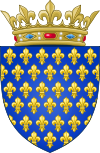
Hugh Capet
(Hugues Capet)3 July 987 24 October 996 • Grandson of Robert I King of the Franks
(Roi des Francs)

Robert II the Pious, the Wise
(Robert II le Pieux, le Sage)24 October 996 20 July 1031 • Son of Hugh Capet King of the Franks
(Roi des Francs)

Henry I
(Henri Ier)20 July 1031 4 August 1060 • Son of Robert II King of the Franks
(Roi des Francs)

Philip I
(Philippe Ier l' Amoureux)4 August 1060 29 July 1108 • Son of Henry I King of the Franks
(Roi des Francs)

Louis VI the Fat
(Louis VI le Gros)29 July 1108 1 August 1137 • Son of Philip I King of the Franks
(Roi des Francs)

Louis VII the Young
(Louis VII le Jeune)1 August 1137 18 September 1180 • Son of Louis VI King of the Franks
(Roi des Francs)

Philip II Augustus
(Philippe II Auguste)18 September 1180 14 July 1223 • Son of Louis VII King of the Franks
(Roi des Francs)
King of France
(Roi de France)

Louis VIII the Lion
(Louis VIII le Lion)14 July 1223 8 November 1226 • Son of Philip II Augustus King of France
(Roi de France)

Louis IX the Saint
(Saint Louis)8 November 1226 25 August 1270 • Son of Louis VIII King of France
(Roi de France)

Philip III the Bold
(Philippe III le Hardi)25 August 1270 5 October 1285 • Son of Louis IX King of France
(Roi de France)

Philip IV the Fair
(Philippe IV le Bel)5 October 1285 29 November 1314 • Son of Philip III King of France and of Navarre
(Roi de France et de Navarre)
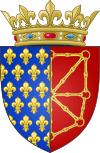
Louis X the Quarreller
(Louis X le Hutin)29 November 1314 5 June 1316 • Son of Philip IV King of France and of Navarre
(Roi de France et de Navarre)

John I the Posthumous
(Jean Ier le Posthume)15 November 1316 20 November 1316 • Son of Louis X King of France and of Navarre
(Roi de France et de Navarre)
Philip V the Tall
(Philippe V le Long)20 November 1316 3 January 1322 • Son of Philip IV
• Younger brother of Louis XKing of France and of Navarre
(Roi de France et de Navarre)

Charles IV the Fair
(Charles IV le Bel)3 January 1322 1 February 1328 • Son of Philip IV
• Younger brother of Philip VKing of France and of Navarre
(Roi de France et de Navarre)Not listed above are Hugh Magnus, eldest son of Robert II, and Philip of France, eldest son of Louis VI; both were co-Kings with their fathers (in accordance with the early Capetian practice whereby Kings would crown their heirs in their own lifetimes and share power with the co-king), but predeceased them. Because neither Hugh nor Philip were sole or senior king in their own lifetimes, they are not traditionally listed as Kings of France, and are not given ordinals.
House of Valois (1328–1589)
Portrait Coat of Arms Name King From King Until Relationship with Predecessor(s) Title 

Philip VI of Valois, the Fortunate
(Philippe VI de Valois, le Fortuné)1 April 1328 22 August 1350 • Son of Charles of Valois, who was son of Philip III King of France
(Roi de France)

John II the Good
(Jean II le Bon)22 August 1350 8 April 1364 • Son of Philip VI King of France
(Roi de France)

Charles V the Wise
(Charles V le Sage)8 April 1364 16 September 1380 • Son of John II King of France
(Roi de France)

Charles VI the Beloved, the Mad
(Charles VI le Bienaimé, le Fol)16 September 1380 21 October 1422 • Son of Charles V King of France
(Roi de France)

Charles VII the Victorious, the Well-Served
(Charles VII le Victorieux, le Bien-Servi)21 October 1422 22 July 1461 • Son of Charles VI King of France
(Roi de France)

Louis XI the Prudent, the Universal Spider
(Louis XI le Prudent, l'Universelle Aragne)22 July 1461 30 August 1483 • Son of Charles VII King of France
(Roi de France)

Charles VIII the Affable
(Charles VIII l'Affable)30 August 1483 7 April 1498 • Son of Louis XI King of France
(Roi de France)Valois–Orléans Branch (1498–1515)
Portrait Coat of Arms Name King From King Until Relationship with Predecessor(s) Title 

Louis XII Father of the People
(Louis XII le Père du Peuple)7 April 1498 1 January 1515 • Great-grandson of Charles V
• Second cousin, and by first marriage son-in-law of Louis XI
• By second marriage husband of Anne of Brittany, widow of Charles VIIIKing of France
(Roi de France)Valois–Angoulême Branch (1515–1589)
Portrait Coat of Arms Name King From King Until Relationship with Predecessor(s) Title 

Francis I the Father and Restorer of Letters
(François Ier le Père et Restaurateur des Lettres)1 January 1515 31 March 1547 • Great-great-grandson of Charles V
• First cousin once removed, and by
first marriage son-in-law of Louis XIIKing of France
(Roi de France)

Henry II
(Henri II)31 March 1547 10 July 1559 • Son of Francis I King of France
(Roi de France)

Francis II
(François II)10 July 1559 5 December 1560 • Son of Henry II King of France and Scotland
(Roi de France et d'Écosse)

Charles IX 5 December 1560 30 May 1574 • Son of Henry II
• Younger brother of Francis IIKing of France
(Roi de France)

Henry III
(Henri III)30 May 1574 2 August 1589 • Son of Henry II
• Younger brother of Charles IXKing of France and Poland
(Roi de France et de Pologne)House of Bourbon (1589–1792)
Portrait Coat of Arms Name King From King Until Relationship with Predecessor(s) Title 
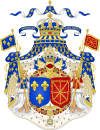
Henry IV, Good King Henry, the Green Gallant
(Henri IV, le Bon Roi Henri, le Vert-Galant)2 August 1589 14 May 1610 • Tenth generation descendant of Louis IX in the male line
• Grandnephew of Francis I
• Second cousin, and by first marriage brother-in-law of Francis II, Charles IX and Henry IIIKing of France and of Navarre
(Roi de France et de Navarre)

Louis XIII the Just
(Louis XIII le Juste)14 May 1610 14 May 1643 • Son of Henry IV King of France and of Navarre
(Roi de France et de Navarre)

Louis XIV the Great, the Sun King
(Louis XIV le Grand, le Roi Soleil)14 May 1643 1 September 1715 • Son of Louis XIII King of France and of Navarre
(Roi de France et de Navarre)

Louis XV the Beloved
(Louis XV le Bien-Aimé)1 September 1715 10 May 1774 • Great-grandson of Louis XIV King of France and of Navarre
(Roi de France et de Navarre)

Louis XVI the Last
(Louis XVI le Dernier)10 May 1774 21 September 1792 • Grandson of Louis XV King of France and of Navarre
(Roi de France et de Navarre)
(1774–1789)
King of the French
(Roi des Français)
(1789–1792)From 21 January 1793 to 8 June 1795, Louis XVI's son Louis-Charles was the titular King of France as Louis XVII; in reality, however, he was imprisoned in the Temple throughout this duration, and power was held by the leaders of the Republic. Upon Louis XVII's death, his uncle (Louis XVI's brother) Louis-Stanislas claimed the throne, as Louis XVIII, but only became de facto King of France in 1814.
First Republic (1792–1804)
The First French Republic lasted from 1792 to 1804, when its First Consul, Napoléon Bonaparte, declared himself Emperor of the French.
Bonaparte Dynasty, First Empire (1804–1814)
Portrait Coat of Arms Name Emperor From Emperor Until Relationship with Predecessor(s) Title 
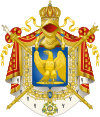
Napoleon I, the Great
(Napoléon Ier, le Grand)18 May 1804 11 April 1814 - Emperor of the French
(Empereur des Français)Capetian Dynasty, House of Bourbon, Restored (1814–1815)
Portrait Coat of Arms Name King From King Until Relationship with Predecessor(s) Title 
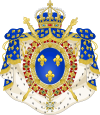
Louis XVIII 11 April 1814 20 March 1815 • Younger brother of Louis XVI/ uncle of Louis XVII King of France and of Navarre
(Roi de France et de Navarre)Bonaparte Dynasty, First Empire, Restored (The Hundred Days, 1815)
Portrait Coat of Arms Name Emperor From Emperor Until Relationship with Predecessor(s) Title 

Napoleon I
(Napoléon Ier)20 March 1815 22 June 1815 - Emperor of the French
(Empereur des Français)From 22 June to 7 July 1815, Bonapartists considered Napoleon I's son Napoleon II as the legitimate heir to the throne, his father having abdicated in his favor. However, the young child's reign was entirely fictional, as he was residing in Austria with his mother. Louis XVIII was reinstalled as king on 7 July.
Capetian Dynasty, House of Bourbon, Restored (1815–1830)
Portrait Coat of Arms Name King From King Until Relationship with Predecessor(s) Title 

Louis XVIII 7 July 1815 16 September 1824 • Younger brother of Louis XVI/ uncle of Louis XVII King of France and of Navarre
(Roi de France et de Navarre)

Charles X 16 September 1824 2 August 1830 • Younger brother of Louis XVIII King of France and of Navarre
(Roi de France et de Navarre)The elder son and heir of Charles X, the Dauphin Louis-Antoine, is occasionally considered to have legally been the King of France as Louis XIX in the 20 minutes that passed between Charles X's formal signature of abdication and the Dauphin's own signature.
Henri d'Artois, Charles X's grandson, was considered by monarchists to be the titular King of France, as Henry V from 2 August 1830 to 9 August 1830, but his reign remained largely fictional, as he acceded in a revolutionary context and hence was never recognized by the French State. He is generally not accounted for in lists of official French monarchs.Capetian Dynasty, House of Orléans (The Monarchy of July 1830–1848)
Second Republic (1848–1852)
The Second French Republic lasted from 1848 to 1852, when its president, Louis-Napoléon Bonaparte, was declared Emperor of the French.
Bonaparte Dynasty, Second Empire, Restored (1852–1870)
Portrait Coat of Arms Name Emperor From Emperor Until Relationship with Predecessor(s) Title 
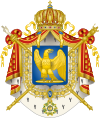
Napoleon III
(Napoléon III)2 December 1852 4 September 1870 • Nephew of Napoleon I Emperor of the French
(Empereur des Français)Government of National Defence (Paris Commune 1870–1871)
The transition period between the fall of the Second Empire after the capture of Napoleon III by the Prussians and the assumption of the Third Republic by General Louis Jules Trochu.
Heads of State following 1871
The chronology of Head of State of France continues with the Presidents of France and short term interim periods by the Chief of State of the French State (1940–1944), the Chairman of the Provisional Government of the French Republic (1944–1946) and the President of the French Senate (1969 and 1974) during the Fifth Republic.
Later pretenders
Various pretenders descended from the preceding monarchs have claimed to be the legitimate monarch of France, rejecting the claims of the President of France, and of each other. These groups are:
- Legitimist claimants to the throne of France—descendants of the Bourbons, rejecting all heads of state since 1830. Unionists recognized the Orléanist claimant after 1883.
- Orléanist claimants to the throne of France—descendants of Louis-Phillippe, a cadet Bourbon, rejecting all heads of state since 1848.
- Bonapartist claimants to the throne of France—descendants of Napoleon I and his brothers, rejecting all heads of state 1815–52, and since 1870.
- Jacobite claimants to the throne of France—descendants of King Edward III of England and thus his claim to the French throne (renounced by Hanoverian King George III upon union with Ireland), also claiming Scotland, and Ireland.
See also
- Coronation of the French monarch
- Bourbon family tree
- English and French monarchs overlap chart
- English Kings of France
- Kings of France family tree
- Members of the French Royal Families
- Style of the French sovereign
References
- Edward James, The Origins of France: Clovis to the Capetians 500-1000. ISBN 0-333-27052-5.
- Edward James, The Franks. Blackwell: 1991. ISBN 0-631-17936-4.
- The history of France as recounted in the Grandes Chroniques de France, and particularly in the personal copy produced for King Charles V between 1370 and 1380 that is the saga of the three great dynasties, the Merovingians, Carolingians, and the Capetian Rulers of France, that shaped the institutions and the frontiers of the realm. It should be noted that this work was commissioned at a time that France was embroiled in the Hundred Years' War with England, a war fought over hereditary claims to the throne of France. It must therefore be read with a careful eye toward biases meant to justify the Capetian claims of continuity and inheritance.
- The Cambridge Illustrated History of France. Cambridge University Press.
- Paul Fouracre and Richard A. Gerberding, Late Merovingian France: History and Hagiography, 640–720. Manchester University Press. ISBN 0-7190-4791-9.
- Patrick Geary, Before France and Germany: The Creation and Transformation of the Merovingian World. Oxford: Oxford U. Press, 1988. ISBN 0-19-504458-4.
- Patrick Geary, The Myth of Nations: The Medieval Origins of Europe. Princeton University Press, 2001. ISBN 0-691-11481-1.
List of French monarchs Detailed Family Tree • Simplified Family TreeMerovingians
(481–751)Clovis I (481–511) • Chlothar I (511–561) • Charibert I (561–567) • Guntram (561–593) • Chilperic I (561–584) • Sigebert I (561–575) • Chlothar II (584–629) • Dagobert I (629–639) • Sigebert II (639–656) • Clovis II (639–657) • Chlothar III (657–673) • Theuderic III (673–691) • Clovis III (691–695) • Childebert III (695–711) • Dagobert III (711–715) • Chilperic II (715–721) • Chlothar IV (717–719) • Thierry IV (721–737) • Childeric III (737–751)Carolingians
(843–888, 898–922, 936–987)Pepin III (751–768) • Carloman I (768–771) • Charlemagne (768–814) • Louis I (814–840) • Charles I (843–877) • Louis II (877–879) • Louis III (879–882) • Carloman II (879–884) • Charles II (885–888) • Charles III (898–922) • Louis IV (936–954) • Lothair IV (954–986) • Louis V (986–987)Robertians
(888–898, 922–923)Eudes of Paris (888–898) • Robert I (922–923)Bosonids
(923–936)Raoul (923–936)House of Capet
(987–1328)Hugh (987–996) • Robert II (996–1031) • Henry I (1031–1060) • Philip I (1060–1108) • Louis VI (1108–1137) • Louis VII (1137–1180) • Philip II (1180–1223) • Louis VIII (1223–1226) • Louis IX (1226–1270) • Philip III (1270–1285) • Philip IV (1285–1314) • Louis X (1314–1316) • John I (1316) • Philip V (1316–1322) • Charles IV (1322–1328)House of Valois
(1328–1498)Philip VI (1328–1350) • John II (1350–1364) • Charles V (1364–1380) • Charles VI (1380–1422) • Charles VII (1422–1461) • Louis XI (1461–1483) • Charles VIII (1483–1498)House of Valois-Orléans
(1498–1515)Louis XII (1498–1515)House of Valois-Angoulême
(1515–1589)Francis I (1515–1547) • Henry II (1547–1559) • Francis II (1559–1560) • Charles IX (1560–1574) • Henry III (1574–1589)House of Bourbon
(1589–1792)Henry IV (1589–1610) • Louis XIII (1610–1643) • Louis XIV (1643–1715) • Louis XV (1715–1774) • Louis XVI (1774–1792) • Louis XVII (claimant, 1792–1795)House of Bonaparte
First Empire (1804–1814, 1815)Napoleon I (1804–1814, 1815) • Napoleon II (1815)House of Bourbon
Bourbon Restoration
(1814, 1815–1830)House of Orléans
July Monarchy (1830–1848)Louis Philippe I (1830–1848)House of Bonaparte
Second Empire (1852–1870)Napoleon III (1852–1870)Categories:- French monarchs
- Lists of monarchs
- Lists of French people
Wikimedia Foundation. 2010.








